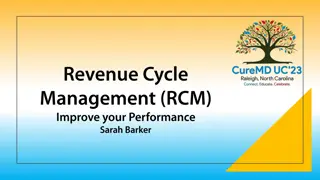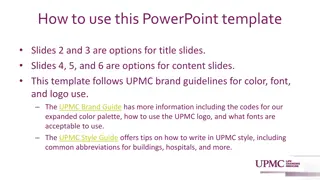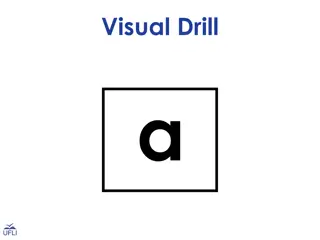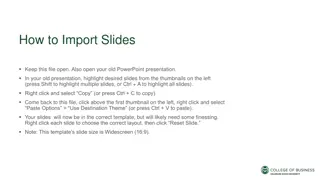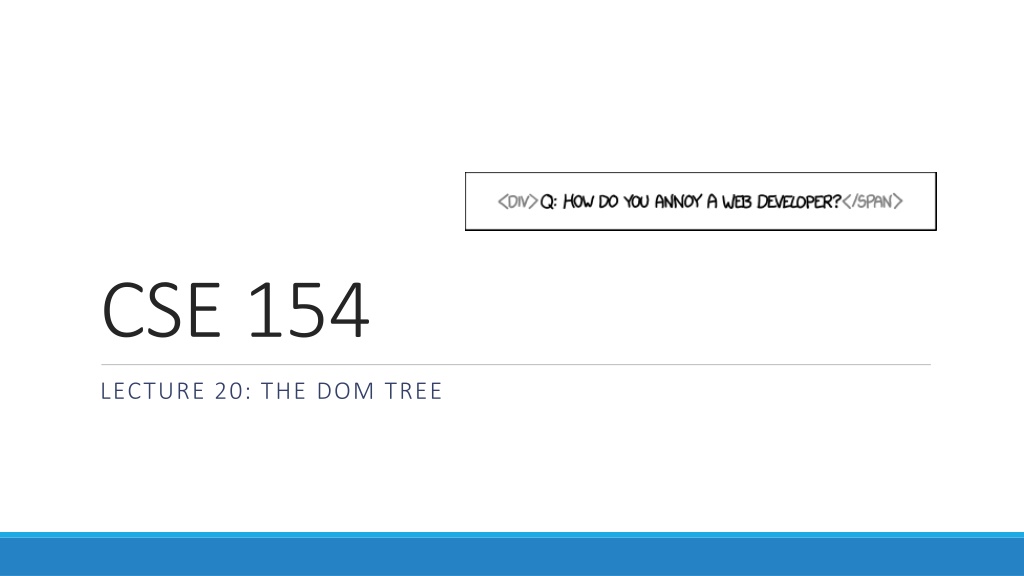
Understanding DOM Manipulation in JavaScript
Learn how to manipulate the Document Object Model (DOM) in JavaScript to create, modify, and interact with elements on a web page. Explore techniques such as setting timers, passing parameters to timers, creating new nodes, and understanding the DOM tree structure. Discover the differences between using DOM methods and innerHTML hacking for efficient and effective web development.
Download Presentation

Please find below an Image/Link to download the presentation.
The content on the website is provided AS IS for your information and personal use only. It may not be sold, licensed, or shared on other websites without obtaining consent from the author. If you encounter any issues during the download, it is possible that the publisher has removed the file from their server.
You are allowed to download the files provided on this website for personal or commercial use, subject to the condition that they are used lawfully. All files are the property of their respective owners.
The content on the website is provided AS IS for your information and personal use only. It may not be sold, licensed, or shared on other websites without obtaining consent from the author.
E N D
Presentation Transcript
CSE 154 LECTURE 20: THE DOM TREE
Setting a timer method description setTimeout(function, delayMS); arranges to call given function after given delay in ms setInterval(function, delayMS); arranges to call function repeatedly every delayMS ms clearTimeout(timerID); clearInterval(timerID); stops the given timer both setTimeout and setInterval return an ID representing the timer this ID can be passed to clearTimeout/Interval later to stop the timer
Passing parameters to timers function delayedMultiply() { // 6 and 7 are passed to multiply when timer goes off setTimeout(multiply, 2000, 6, 7); } function multiply(a, b) { alert(a * b); } JS output any parameters after the delay are eventually passed to the timer function doesn't work in IE; must create an intermediate function to pass the parameters why not just write this? setTimeout(multiply(6 * 7), 2000); JS
The DOM tree The elements of a page are nested into a tree-like structure of objects the DOM has properties and methods for traversing this tree
DOM versus innerHTML hacking Why not just code the previous example this way? function slideClick() { document.getElementById("main").innerHTML += "<p>A paragraph!</p>"; } JS Imagine that the new node is more complex: ugly: bad style on many levels (e.g. JS code embedded within HTML) error-prone: must carefully distinguish " and ' can only add at beginning or end, not in middle of child list function slideClick() { document.getElementById("main").innerHTML += "<p style='color: red; " + "margin-left: 50px;' " + "onclick='myOnClick();'>" + "A paragraph!</p>"; } JS
Creating new nodes name description creates and returns a new empty DOM node representing an element of that type document.createElement("tag") document.createTextNode("text") creates and returns a text node containing given text // create a new <h2> node var newHeading = document.createElement("h2"); newHeading.innerHTML = "This is a heading"; newHeading.style.color = "green"; JS merely creating a element does not add it to the page you must add the new element as a child of an existing element on the page...
Modifying the DOM tree Every DOM element object has these methods: name description appendChild(node) places given node at end of this node's child list insertBefore(new, old) places the given new node in this node's child list just before old child removeChild(node) removes given node from this node's child list replaceChild(new, old) replaces given child with new node var p = document.createElement("p"); p.innerHTML = "A paragraph!"; document.getElementById("main").appendChild(p); JS A paragraph!
Complex DOM manipulation problems How would we do each of the following in JavaScript code? Each involves modifying each one of a group of elements ... When the Go button is clicked, reposition all the divs of class puzzle to random x/y locations. When the user hovers over the maze boundary, turn all maze walls red. Change every other item in the ul list with id of TAs to have a gray background.
Selecting groups of DOM objects methods in document and other DOM objects (* = HTML5): name description getElementsByTagName returns array of descendents with the given tag, such as "div" returns array of descendents with the given name attribute (mostly useful for accessing form controls) getElementsByName returns the first element that would be matched by the given CSS selector string querySelector * returns an array of all elements that would be matched by the given CSS selector string querySelectorAll *
Getting all elements of a certain type highlight all paragraphs in the document: var allParas = document.querySelectorAll("p"); for (var i = 0; i < allParas.length; i++) { allParas[i].style.backgroundColor = "yellow"; } JS <body> <p>This is the first paragraph</p> <p>This is the second paragraph</p> <p>You get the idea...</p> </body> HTML
Complex selectors highlight all paragraphs inside of the section with ID "address": // document.getElementById("address").getElementsByTagName("p") var addrParas = document.querySelectorAll("#address p"); for (var i = 0; i < addrParas.length; i++) { addrParas[i].style.backgroundColor = "yellow"; } JS <p>This won't be returned!</p> <div id="address"> <p>1234 Street</p> <p>Atlanta, GA</p> </div> HTML
Common querySelectorAll issues many students forget to write . or # in front of a class or id // get all buttons with a class of "control" var gameButtons = document.querySelectorAll("control"); var gameButtons = document.querySelectorAll(".control"); JS querySelectorAll returns an array, not a single element; must loop over the results (document.querySelector returns just the first element that matches, if that's what you want) // set all buttons with a class of "control" to have red text document.querySelectorAll(".gamebutton").style.color = "red"; var gameButtons = document.querySelector(".gamebutton"); for (var i = 0; i < gameButtons.length; i++) { gameButtons[i].style.color = "red"; } Q: Can I still select a group of elements using querySelectorAll even if my CSS file doesn't have any style rule for that same group? (A: Yes!)
Removing a node from the page function slideClick() { var bullet = document.getElementById("removeme"); bullet.parentNode.removeChild(bullet); } JS odd idiom: obj.parentNode.remove(obj);
The keyword this this.fieldName // access field this.fieldName = value; // modify field this.methodName(parameters); // call method JS all JavaScript code actually runs inside of an object by default, code runs in the global window object (so this === window) all global variables and functions you declare become part of window the this keyword refers to the current object
Event handler binding window.onload = function() { document.getElementById("textbox").onmouseout = booyah; document.getElementById("submit").onclick = booyah; }; // bound to submit button here function booyah() { // booyah knows what object it was called on this.value = "booyah"; } JS output event handlers attached unobtrusively are bound to the element inside the handler, that element becomes this
Problems with reading/changing styles <button id="clickme">Click Me</button> HTML window.onload = function() { document.getElementById("clickme").onclick = biggerFont; }; function biggerFont() { var button = document.getElementById("clickme"); var size = parseInt(button.style.fontSize); button.style.fontSize = (size + 4) + "pt"; } JS output style property lets you set any CSS style for an element problem: you cannot read existing styles with it (you can read ones you set using the DOM .style, but not ones that are set in the CSS file)
Accessing elements' existing styles window.getComputedStyle(element).propertyName JS function biggerFont() { // turn text yellow and make it bigger var clickMe = document.getElementById("clickme"); var size = parseInt(window.getComputedStyle(clickMe).fontSize); clickMe.style.fontSize = (size + 4) + "pt"; } JS output getComputedStyle method of global window object accesses existing styles
Common bug: incorrect usage of existing styles the following example computes e.g. "200px" + 100 + "px" , which would evaluate to "200px100px" var main = document.getElementById("main"); main.style.top = window.getComputedStyle(main).top + 100 + "px ; // bad! JS a corrected version: main.style.top = parseInt(window.getComputedStyle(main).top) + 100 + "px"; // correct JS
Getting/setting CSS classes function highlightField() { // turn text yellow and make it bigger var text = document.getElementById("text"); if (!text.className) { text.className = "highlight"; } else if (text.className.indexOf("invalid") < 0) { text.className += " highlight"; // awkward } } JS JS DOM's className property corresponds to HTML class attribute somewhat clunky when dealing with multiple space-separated classes as one big string
Getting/setting CSS classes with classList function highlightField() { // turn text yellow and make it bigger var text = document.getElementById("text"); if (!text.classList.contains("invalid")) { text.classList.add("highlight"); } } JS classList collection has methods add, remove, contains, toggle to manipulate CSS classes similar to existing className DOM property, but don't have to manually split by spaces
Types of DOM nodes <p> This is a paragraph of text with a <a href="/path/page.html">link in it</a>. </p> HTML element nodes (HTML tag) can have children and/or attributes text nodes (text in a block element) attribute nodes (attribute/value pair) text/attributes are children in an element node cannot have children or attributes not usually shown when drawing the DOM tree
Traversing the DOM tree manually every node's DOM object has the following properties: name(s) description firstChild, lastChild start/end of this node's list of children childNodes array of all this node's children nextSibling, previousSibling neighboring nodes with the same parent parentNode the element that contains this node complete list of DOM node properties browser incompatiblity information (IE6 sucks)
DOM tree traversal example <p id="foo">This is a paragraph of text with a <a href="/path/to/another/page.html">link</a>.</p> HTML
Element vs. text nodes <div> <p> This is a paragraph of text with a <a href="page.html">link</a>. </p> </div> HTML Q: How many children does the div above have? A: 3 an element node representing the <p> two text nodes representing "\n\t" (before/after the paragraph) Q: How many children does the paragraph have? The a tag?






